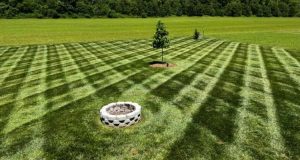As autumn descends, painting the landscape in vibrant hues of red, orange, and yellow, it’s easy to overlook your lawn in the hustle and bustle of seasonal activities. However, this is the perfect time to give your grass some much-needed attention. Aerating and overseeding your lawn in the fall not only prepares your yard for a vibrant spring but also enhances its overall health and appearance. Let’s delve into the benefits of these practices and how they can transform your lawn into a lush, green paradise.
Understanding aeration and overseeding
Aeration is the process of perforating the soil with holes to allow air, water, and nutrients to penetrate deeper into the root system. This practice alleviates soil compaction, improves drainage, and promotes better root growth. On the other hand, overseeding involves spreading new grass seed over your existing lawn. This process fills in bare patches, enhances density, and introduces new grass varieties that can withstand environmental stressors.
Together, aeration and overseeding are like a dynamic duo for your lawn, working synergistically to create a healthier, more resilient yard.
Why fall is the ideal time
1. Optimal Temperature for Growth
Fall temperatures
the benefits of aerating your lawn
- Alleviating Soil Compaction
Soil compaction can significantly hinder grass growth. Heavy foot traffic, clay soil, and excessive rainfall can compress the soil, making it difficult for roots to expand and absorb necessary nutrients. Aeration breaks up compacted soil, allowing roots to penetrate deeper and access the resources they need to thrive. - 2. Improving Nutrient Absorption
When soil is compacted, nutrients struggle to reach the roots. Aeration creates channels for fertilizers and organic matter to enter the soil, enhancing nutrient absorption. This means that your grass will receive the food it needs to grow lush and healthy.
3. Enhancing Water Infiltration
Poor drainage can lead to water pooling and runoff, depriving your grass of moisture. Aeration helps improve water infiltration, ensuring that rain and irrigation penetrate deeply into the soil rather than running off. This leads to a more efficient watering system and healthier grass.
4. Promoting Root Growth
Healthy roots are essential for a thriving lawn. Aeration promotes root growth by loosening the soil, allowing roots to expand without restrictions. Stronger roots lead to a more resilient lawn capable of withstanding stress from heat, drought, and pests.
The benefits of overseeding your lawn
- Filling in Bare Spots
Overseeding is an effective way to fill in bare patches in your lawn, giving it a fuller appearance. Whether caused by foot traffic, pests, or environmental stressors, overseeding revitalizes your lawn’s aesthetic. - Introducing Disease-Resistant Varieties
Overseeding allows you to introduce new grass varieties that are more resistant to diseases and pests. For instance, if your lawn has struggled with a specific disease, overseeding with a more resilient variety can improve overall health and reduce future issues. - Improving Lawn Density
A thick, dense lawn is not only visually appealing but also helps prevent weeds from taking root. Overseeding increases the density of your grass, creating a lush carpet that chokes out potential invaders. - Enhancing Color and Texture
By selecting the right seed mix, overseeding can enhance the color and texture of your lawn. This is particularly beneficial if your existing grass is looking patchy or tired. Fresh seeds can breathe new life into your yard, making it the envy of the neighborhood.
how to aerate and overseed your lawn
- Prepare Your Lawn
Before starting, mow your lawn to a lower height than usual, around 1.5 to 2 inches. This helps the seeds make good contact with the soil. Additionally, remove any debris, such as leaves or sticks, to ensure a clean workspace. - Aerate Your Lawn
Using a core aerator, create holes in your lawn every few inches. This machine removes small plugs of soil, allowing air and nutrients to penetrate. If you don’t have access to a core aerator, many garden centers offer rental options. - Overseed Your Lawn
After aeration, it’s time to overseed. Use a high-quality seed blend suited for your region and lawn type. Distribute the seeds evenly across the aerated areas, ensuring good coverage. You can use a broadcast spreader for more uniform distribution. - Water and Fertilize
After overseeding, lightly water your lawn to keep the soil moist. Avoid heavy watering, which can wash the seeds away. Applying a starter fertilizer can also help your new grass establish itself quickly, providing the necessary nutrients it needs to thrive. - Maintain Your Lawn
Once the seeds have germinated, continue to water your lawn regularly, keeping the soil consistently moist. As the new grass grows, gradually reduce watering frequency but increase the amount of water per session. Mow as needed, but avoid cutting too short, which can stress new grass.
common mistakes to avoid
- Neglecting Soil Testing
Before aerating and overseeding, consider testing your soil. Understanding your soil’s pH and nutrient levels can guide you in selecting the right grass seed and fertilizers. - Ignoring Weather Conditions
Timing is crucial for successful aeration and overseeding. Avoid aerating when the soil is too wet, as this can lead to further compaction. Conversely, if the soil is too dry, it may be challenging for the seeds to germinate. - Using Poor-Quality Seed
Investing in high-quality grass seed is essential for the success of your overseeding efforts. Cheaper seeds may not germinate as well and can lead to a patchy lawn. Look for seeds specifically formulated for your region and lawn type. - Overwatering
While it’s important to keep the soil moist, overwatering can wash away seeds and create soggy conditions that promote disease. Ensure that you are watering appropriately based on the weather and soil conditions.
conclusion
As the vibrant colors of fall envelop your landscape, take advantage of this season to enhance your lawn’s health and beauty. Aerating and overseeding not only prepares your grass for the colder months but also sets the stage for a lush, green lawn come spring.
By investing a little time and effort in these practices, you’ll reap the benefits of a thriving lawn that enhances your home’s curb appeal and provides a welcoming space for outdoor activities. So grab your aerator and seeds, and let the transformation begin!
With the right care, your lawn will be the pride of the neighborhood, a lush oasis that beckons family and friends to enjoy the great outdoors.







